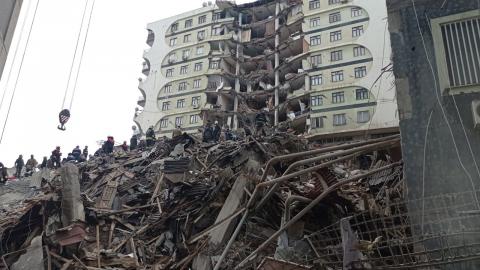7.7 magnitude earthquake strikes Myanmar
A powerful 7.7 magnitude earthquake with an epicentre near the city of Mandalay in Myanmar (formerly Burma) has been felt in cities as far away as Bangkok, the capital of Thailand, more than 1,300 kilometres away. The earthquake was shallow - 10 kilometres - and has been followed by several aftershocks, according to the US Geological Survey (USGS).

Bill McGuire - terremoto myanmar EN
Bill McGuire
Professor Emeritus of Geophysical & Climate Hazards, University College London
Myanmar is one of the most seismically active countries in the world, so this quake is not a surprise. It looks to have occurred on the major Sagaing Fault, which marks the boundary between two tectonic plates, and which runs north - south close to a number of large population centres.
This is probably the biggest earthquake on the Myanmar mainland in three quarters of a century, and a combination of size and very shallow depth will maximise the chances of damage. It is highly likely that build quality will generally not be high enough to survive this level of shaking, and casualty numbers will almost certainly climb significantly as more becomes known of the scale of the disaster.
There has already been one sizeable aftershock and more can be expected. This will threaten the collapse of weakened buildings and make the jobs of rescue workers that much more challenging.
Joanna Faure Walker - terremoto myanmar EN
Joanna Faure Walker
Professor of Earthquake Geology and Disaster Risk Reduction, University College London (UCL)
Myanmar is no stranger to earthquakes. The plate boundary between the India Plate and Eurasia Plate runs approximately north-south, cutting through the middle of the country. These two plates move past each other as they are moving at different rates along a transform plate boundary (a bit like the San Andreas Fault in the south west of the United States).
Although such strike slip earthquakes are of smaller magnitude than the largest earthquakes seen in subduction zones, like to the south in Sumatra, they can still reach magnitudes 7 to 8 and cause severe destruction, as we are seeing in the March 2025 earthquake.
Roger Musson - terremoto myanmar EN
Roger Musson
Honorary Research Fellow, British Geological Survey (BGS)
Large earthquakes in this region are rare but not unknown, the last similar event being in 1956, more or less beyond living memory. This means that buildings are unlikely to be designed against seismic forces, and therefore are more vulnerable when an earthquake like this occurs, resulting in more damage and higher casualties. The ultimate cause of the earthquake is the northward movement of the Indian Plate, which produces a tearing effect along N-S trending vertical faults.
Ilan Kelman - terremoto myanmar EN
Ilan Kelman
Professor of Disasters and Health, Institute for Risk and Disaster Reduction (IRDR), University College London (UCL)
Getting humanitarian relief into the worst-affected areas of Burma / Myanmar might not be politically easy. In 2008, Cyclone Nargis killed over 130,000 people in the country. The government took days to accept significant aid and then inhibited its delivery.
For 'disaster diplomacy' to work - supporting disaster-affected people in areas with violent or political conflict - the world and the disaster-struck authorities must cooperate. Many governments running Burma / Myanmar have been highly controlling, including since the February 2021 military coup. Helping people in need without helping an oppressive government is a tricky situation for aid donors to navigate, not helped by the reported damage to transportation and communication systems.
The usual mantra is that 'Earthquakes don't kill people; collapsing infrastructure does'. Governments are responsible for planning regulations and building codes. This disaster exposes what governments of Burma / Myanmar failed to do long before the earthquake which would have saved lives during the shaking.
Declared interests: Ilan has been researching disaster diplomacy since 1999



